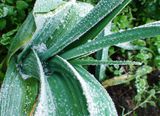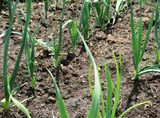Leek
| Leek | |
|---|---|

| |
| Large earth bumblebee on leek flower | |
| Scientific classification | |
| Kingdom: | Plantae |
| Order: | Asparagales |
| Family: | Amaryllidaceae |
| Subfamily: | Allioideae |
| Tribe: | Robinieae |
| Genus: | Allium |
| Species: | A. ampeloprasum |
| Subspecies: | A. ampeloprasum var. porrum |
| Binomial name | |
| Allium ampeloprasum var. porrum | |
Leek, according to some researchers, was already part of the the Egyptian and Mesopotamian diet at least from the 2nd millennium BCE onwards.
Fertilize your soil well with compost. Sow summer leek plants from January to April inside in a shallow box or in a row in greenhouse or in a cold frame. Sow winter leek from March to the first half of May in the same way. You can also sow directly in the soil, this gives you less trouble with the leek fly.
Transplant when the plants are as thick as a pencil. Make trenches of 20 cm deep and plant leek in these trenches. You can also plant in holes made with the backside of the stick of one of your garden tools. You can hill up the plants as they grow but prevent soil from coming between the leaves.
You can also plant them in a normal way, that is not in trenches or holes. I did this with the summer leek shown in the photo (taken in June).
You can harvest summer leek from June to the end of autumn and winter leek from early autumn until the next spring. The winter leek species are hardy.
Garden Journal
- See also Garden Journal for a list with all plants with a garden journal section.
November 2010 - Winter leek frozen.
December 2011 - Leek plants in midwinter. This is a species of leek that grows through the winter and can be harvested in spring.
February 2012 - Winter leek after several weeks of very low freezing temperatures.
June 18, 2012 - This leek was sown in April and planted out in May, in a field with a good gift of compost, and deeply dug. Summer leek grows fast and these plants can probably be harvested in two months and will then be as thick as a wrist.
See also
External links
- Leek Wikipedia




